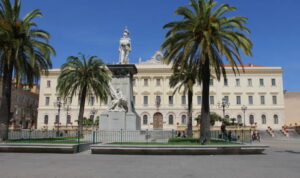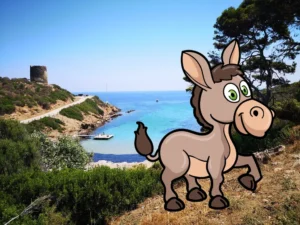Table of Contents
Exploring Su Nuraxi: A Guide to the Ancient Nuragic Complex in Sardinia
Sardinia, the stunning Mediterranean island known for its picturesque landscapes and rich history, is home to one of the world’s most fascinating ancient structures – Su Nuraxi. This nuragic complex, located in the town of Barumini, is a UNESCO World Heritage Site that offers a glimpse into the enigmatic Nuragic civilization that thrived on the island during the Bronze Age. In this comprehensive guide, we will delve into the captivating history, architectural marvels, and cultural significance of Su Nuraxi.
Unearthing the Nuragic Civilization
To truly appreciate Su Nuraxi, it is important to understand the context in which it was built. The Nuragic civilization, which inhabited Sardinia from approximately 1900 to 730 BC, left behind a legacy of unique megalithic structures known as nuraghe. These stone towers, found exclusively on the island, served as both defensive fortresses and possibly religious sites. It is estimated that there were once over 10,000 nuraghe scattered across Sardinia, although around 7,000 remain today.
Discovering Su Nuraxi
Among the numerous nuraghe in Sardinia, Su Nuraxi stands out as the most renowned and well-preserved complex. Excavations carried out by Sardinian archaeologist Giovanni Lilliu in the mid-20th century revealed the remarkable history and architectural grandeur of this ancient site. Su Nuraxi comprises a central tower, known as the “mastio,” and four smaller towers connected by a bastion. Surrounding these structures are a labyrinth of 50 huts, wells, and cisterns, creating a unique and sprawling village.

Unraveling the Layers of History
The construction of Su Nuraxi unfolded over a span of 2,000 years, from the 16th century BC to the 7th century AD. The initial phase saw the erection of the mastio, a Middle Bronze Age tower made of basalt sourced from the nearby Giara Plateau. This imposing tower, originally standing at a height of 18.6 meters, consisted of three interconnected rooms with gradually diminishing diameters. Its distinctive false dome-shaped roof, known as a tholos, added to its architectural significance.
During the Later Bronze Age, the complex underwent further expansion. Four smaller towers, each with two stacked rooms, were added to the main tower. These towers, reaching a height of 14 meters, were connected by curtain walls and oriented towards the cardinal points. The bastion, a quadrilobed structure, provided access to a courtyard with a well, connecting the various towers. The village surrounding Su Nuraxi also flourished during this period, with circular huts featuring conical wooden roofs.
A Glimpse into Nuragic Life
The huts within the village of Su Nuraxi offer invaluable insights into the daily life and social organization of the Nuragic civilization. One of the most significant huts is known as “capanna 80,” or the “assembly hut.” This circular structure features a perimeter bench and five niches in the walls, which once held votive objects, tools, weapons, and ornaments. These findings suggest that the hut served as a gathering place for community assemblies and possibly religious ceremonies.
As the Iron Age dawned, the village of Su Nuraxi underwent a transformation. New huts, characterized by circular walls and multiple rectangular rooms, were constructed in a radial pattern around a paved courtyard. The most remarkable addition was the “rotonda,” a small tholos-covered room with a central basin used for water rituals. This architectural evolution reflects the changing societal dynamics and cultural influences that impacted Sardinia during this period.
The Punic Influence and Roman Legacy
In the 5th century BC, the Nuragic civilization encountered the Carthaginians, who established a presence on the island. The Punic and Nuragic cultures coexisted, with minimal impact on the architecture and lifestyle of the nuraghe. However, during the Roman period, some areas of Su Nuraxi were repurposed as burial sites, indicating the continued significance of the complex even in the face of external influences. The site remained inhabited until the 3rd century AD and sporadically frequented until the 7th century AD.
Preserving Su Nuraxi for Future Generations
Recognizing the exceptional value of Su Nuraxi, UNESCO designated it as a World Heritage Site in 1997. Since then, extensive preservation efforts have been undertaken to safeguard this archaeological treasure. Visitors can explore the site and immerse themselves in the ancient Nuragic civilization through guided tours and interactive exhibits. The nearby Cultural Center, named after Giovanni Lilliu, offers a range of educational activities, exhibitions, concerts, and workshops throughout the year.
Visiting Su Nuraxi: Practical Information
To make the most of your visit to Su Nuraxi, it is essential to plan ahead. The complex is easily accessible by car or public transportation, with Barumini being the nearest town. Guided tours are available, providing in-depth knowledge and a deeper understanding of the site’s historical and cultural significance. It is advisable to wear comfortable footwear and bring sun protection, as the tour involves walking through the extensive archaeological area.
Exploring Beyond Su Nuraxi
While Su Nuraxi is undoubtedly the crown jewel of Nuragic architecture, Sardinia boasts many other nuraghe worth exploring. From the majestic Nuraghe Losa in Abbasanta to the enchanting Nuraghe Santu Antine in Torralba, each site offers a unique glimpse into the island’s ancient past. Exploring these lesser-known nuraghe allows for a comprehensive understanding of the Nuragic civilization and its impact on Sardinia’s cultural heritage.
Embracing the Mysteries of Su Nuraxi
Su Nuraxi stands as a testament to the ingenuity and cultural richness of the Nuragic civilization. Its towering structures and intricate village layout offer a captivating window into Sardinia’s ancient past. Whether you are a history enthusiast, an architectural aficionado, or simply a curious traveler, a visit to Su Nuraxi promises an unforgettable experience. So, embark on a journey through time and immerse yourself in the wonders of this extraordinary ancient complex in the heart of Sardinia.
Please note that this article is intended to provide an overview of Su Nuraxi and should not replace professional archaeological advice or guidance. Visitors are encouraged to follow the regulations and recommendations provided by local authorities and cultural institutions.



